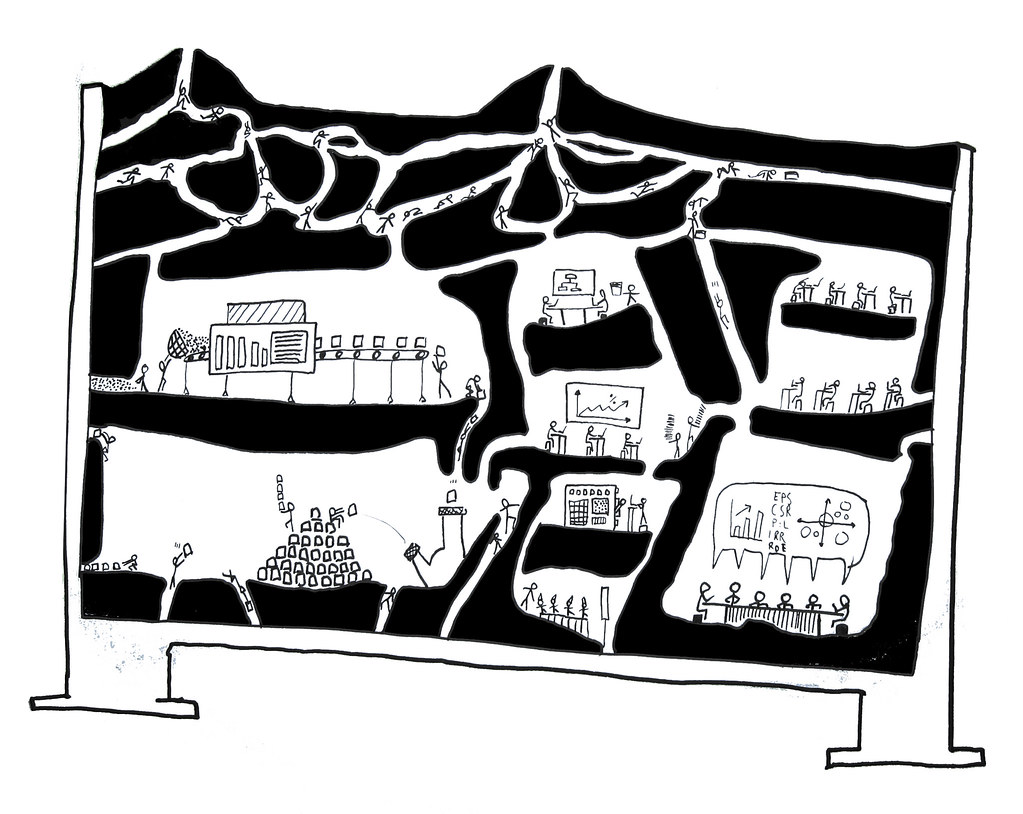In the movie Inside Job, George Soros makes an analogy that made an impression on me. He talks about how oil tankers have partitions in their hulls with their oil divided across the compartments. That way when the seas are rough the oil sloshes around within its own restricted space rather than the entire cargo splashing forward and back the full length of the ship, as would happen if there were no partitions. This obviously makes the tanker more stable.
The analogy is to financial markets and regulation. Erecting partitions to make the market less liquid should improve stability. At first you say, oh that’s a nice piece of rhetoric but financial markets aren’t anything like oil tankers. At least I said that.
But let’s take it for a spin. Let’s analyze the partitioned tanker but forget that it is a mechanical system and instead analyze it in the same way we would use equilibrium theory to analyze a market. Here goes.
There is a shock (rough seas) and the oil starts to spill to one end of the boat. But the partition stops the oil from going where it wants to go. There is a friction in the market. The oil in one compartment and the empty space in the adjacent compartment want to make a voluntary exchange. And it would be Pareto improving (otherwise they wouldn’t want to do it.) But that partition is stopping them. This is welfare-reducing.
Moreover, there is a powerful incentive for arbitrage. Any small leak in the partition would allow equilibrium to be reached by removing the friction, allowing the oil to go where it wants to go, and relieving some internal pressure. That must be welfare-improving.
If you think about it, market models pretty much stop there. Pareto improving trades should and do happen. Financial innovation brings down those partitions and that’s good. What is almost always missing is any way of talking about the hard-to-define but clearly very real externality that is the effect of these trades on the stability of the system as a whole. That’s about process and transitional dynamics, not about equilibrium.
Indeed, in equilibrium the oil in the tanker is in the same place whether or not the partitions are there.
(drawing: The Bigger Picture from www.f1me.net)


7 comments
Comments feed for this article
September 12, 2011 at 9:15 pm
Talosaga
This reminds me of a paper I read that used an ecology to understand banking. I think this is the paper.
http://www.nature.com/nature/journal/v469/n7330/full/nature09659.html
In one of their little models they imagined that there are lots of countries in the world that recieve uncorrelated economic shocks every so often. Say each country has one bank for simplicity. There is a “autarky” arangement with all banks holding only domestic assets and a “intergrated” arangement where banks diversify risk by holding assets from all countries.
In autarky, each country’s bank has a higher probability of failing because they cannot diversify risk. However, these domestic banking failures will be uncorrelated. With integration, all banks have a lower probability of failure, but because the all hold a more homogeneous portfolio of investments, these failures will be correlated. Probability of a single banking failure goes down, but the probability of a worldwide banking crisis goes up.
Therefore, “financial partitions” between countries can make the world better off by making global crises less likely.
The blog http://www.macroresilience.com goes over these type of issues quite a lot.
September 12, 2011 at 10:45 pm
johannes
This was the analysis we get from a Northwestern Economist? Really?
“I guess we are like an oil tanker, so let’s do the oil tanker thing!”
Really?
September 13, 2011 at 1:11 am
Economist's View: "Tankers and Bankers"
[…] Ely: Tankers and Bankers, by Jeff Ely, Cheap Talk: In the movie Inside Job, George Soros makes an analogy that made an impression on me. He talks […]
September 13, 2011 at 8:26 am
Anonymous
I quite like the partition analogy but in the oil case, it is a common external shock that causes the oil to shift. All the partition does is reduce its scale to a level that is non-threatening to the tanker. I am not convinced financial systems work like that. We have market circuit breakers and I think the evidence is mixed on their effectiveness.
See for instance:
http://papers.ssrn.com/sol3/papers.cfm?abstract_id=162571
September 13, 2011 at 9:07 am
Anonymous
IIRC, there are not partitions, but anti-slosh barriers – partitions with holes which allow a slower movement of oil.
September 13, 2011 at 11:33 am
Tuesday links: jack of all trades | Abnormal Returns
[…] interesting analogy that includes tankers, bankers and market regulation. (Cheap Talk via Economist’s […]
September 21, 2011 at 12:30 am
Petroleros y bancos | Euribor
[…] otro día, en la web de Cheaptalk comentaban la analogía que hacía George Soros en la película Inside Job. Habla sobre cómo los […]